AR & Collections
Accounts Receivable
Support Guide
-
Overview
Transactions are anything that posts to your General Ledger, and in the case of A/R Transactions, anything that posts to your A/R Account(s). A/R Transactions do not include Sales Orders as they do not post to your General Ledger until they are invoiced. This guide will explore different A/R Transactions that will affect your Collections process including Invoices, Payments, and Credit Memos and how each function in Striven.
Read this guide if you are trying to:
✔ Manage AR Settings in Striven.
✔ Understand and utilize the Transactions List.
✔ Report on financial transactions.
-
A/R Settings
Before your Company starts to receive Sales Orders in Striven, it is recommended you visit the A/R Settings to ensure your Accounts Receivable suits your Company’s needs. Here you can note the next available number(s) for Sales Orders and transactions, when to process Auto-Pay, and more. Below is a screenshot demonstrating how the A/R Settings appear and details of what can be accomplished there.
To view A/R Settings, use the following steps below:
Company → Settings → Accounting → AR → Settings
- General: This section has many options, which are described further below:
- Require Bill To/Ship To: Establishes whether you wish to require Customer Bill To and Ship To addresses on Sales Orders and A/R Transactions including Invoices, Credit Memos, etc.
- Default Sales Rep on Creation: If a Category is selected, the Sales Rep will be whomever is assigned at the Customer level for that Category. If no one is assigned, the default Sales Rep will be the person creating the Sales Order, Invoice, or Sales Receipt.
- Allow Grouping of Line Items for Sales Orders, Invoices, and Sales Receipts: Enables the ability to organize Items into groups on AR entries.
- Show Cost and Markup: Establishes whether you want to calculate cost and markup on Sales Orders and A/R Transactions including Invoices, Credit Memos, etc.
- Prompt to update the Item Cost if it is changed while creationg Sales Orders and Invoices: Establishes whether you want the cost and/or markup Items updated if they are changed on Sales Orders and Invoices.
- Show Profit in Subtotals: Establishes whether you want to show estimated profits on Sales Orders and A/R Transactions including Invoices, Credit Memos, etc.
- Sales Orders: Global settings options for Sales Orders. These options include:
- Auto-Expire Recurring Sales Orders: Establishes whether you set recurring Sales Orders to automatically expire.
- Lead Time for Invoice Generation: Designates how far in advance recurring Sales Orders are generated.
- Allow 0 Quantity Line Items on Sales Orders: Provides the ability to include Line Items on Sales Orders with a 0 quantity.
- Invoices: There are many options in the Invoices section including the following:
- Next Number: Here you can choose the next available number for Invoices created in Striven.
- From Email: Displays an email address on Invoice emails sent to Customers from Striven so they see an email address they are familiar with and can recognize.
- From Name: Displays a name on Invoice emails sent to Customers from Striven so they see a name they are familiar with and can recognize.
- From Category: If a Category is selected, the Invoice will be sent from whomever is assigned at the Customer level for that Category. If no one is assigned, the default Invoice from email and name would be used.
- Payment Terms: Designates the default Payment Terms for Invoices.
- Format: Allows you to set the default format used when creating Invoices.
- Automatically Generate the Invoice PDF for Printing Once a Day.
- Don’t Set Invoices “To Be Printed” if on Auto-Pay: For Customers with Auto-Pay enabled, their Invoices will not be set to be printed by default.
- Ignore Lead Time on Sales Orders if on Auto-Pay: For Customers with Auto-Pay enabled, any Lead Times on Sales Orders will be disregarded.
- Ignore Lead Time if Invoices are NOT set “To Be Printed”: Lead Time on Invoices that are not set “To Be Printed” will be disregarded.

Example of A/R Settings Page

- General: This section has many options, which are described further below:
-
A/R Additional Configuration
Within the A/R Settings, you can also configure how A/R Transactions function including Credit Memos, Payments, Sales Receipts, and Finance Charges. Below is a screenshot displaying how the A/R Settings appear and details on what can be accomplished there.
- Credit Memos: Allows you to choose the next available number for Credit Memos created in Striven and decide if open Credit Memos are automatically applied to the oldest Invoices during nightly background Invoice process windows.
- Sales Receipts: Allows you to choose the next available number for Sales Receipts created in Striven.
- Payments: This section contains many options, which are described below:
- Next Number: Allows you to choose the next available number for Payments created in Striven.
- Send Invoice Payment Receipt: Designates whether an Invoice Payment receipt will be sent to the Customer.
- Process Auto-Pay on: Allows you to choose whether to process Auto-Pay based on Due Dates or Invoice Dates.
- Don’t process Auto-Pay on Accounts with Open Credits and Payments: Determines whether or not to process Auto-Pay for Customers with Open Credits and Open Payments.
- Failed Payment Notification Recipients: Allows you to choose an internal user who will be notified when Customer Payments fail to be processed so that the Customer can be notified.
- During nightly automated Invoice creation process apply Open Payments to oldest Invoices: Determines if you would like open Payments to be automatically applied to the oldest Invoices during nightly background Invoice process windows.
- Finance Charges: Allows you to designate the Item associated with Finance Charges along with the Annual Rate and minimum amount to charge.
- Save: Saves your changes.
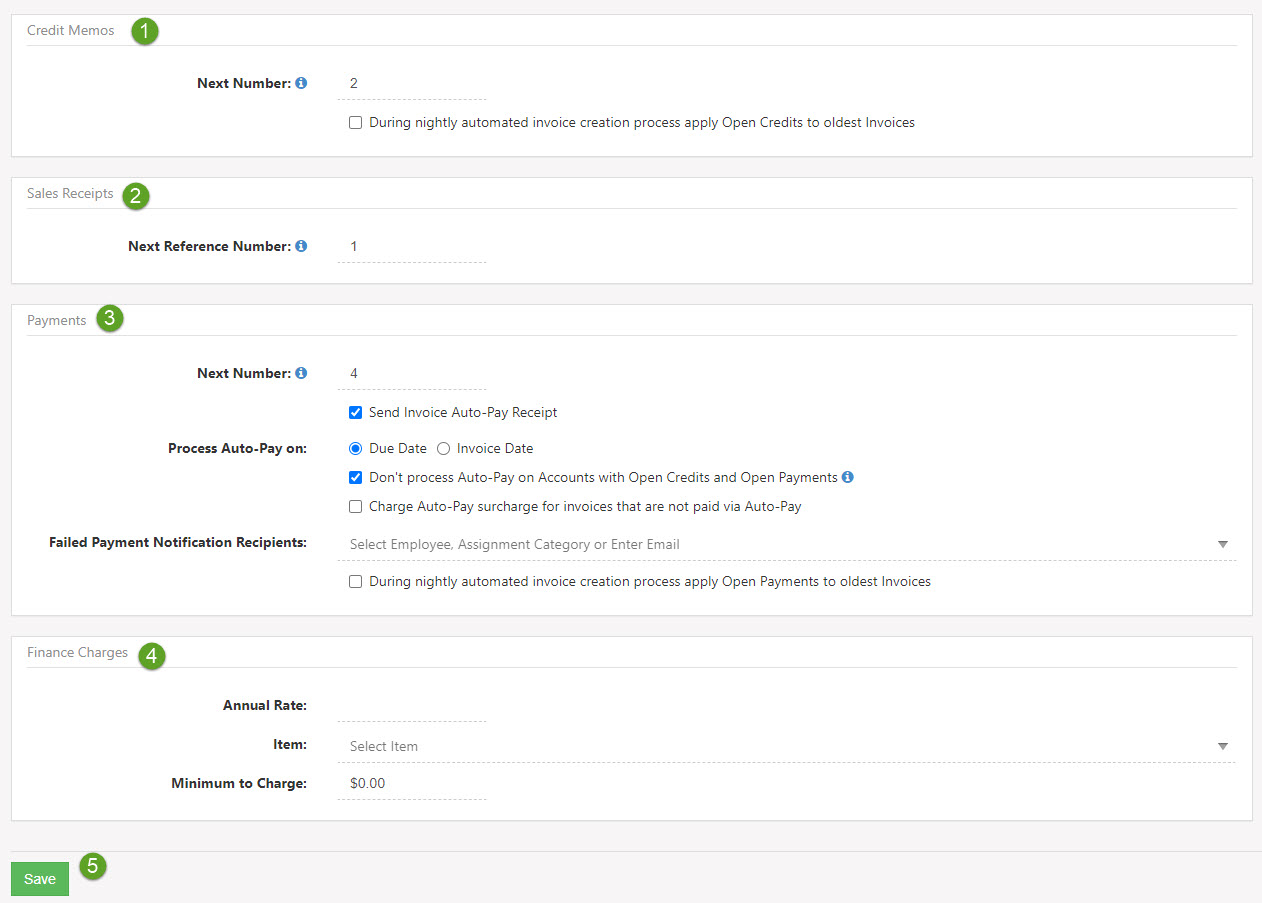
Example of A/R Settings page (continued)

-
Payment Terms
Payment Terms are time conditions on which two parties agree to fulfill a sale by a certain date or period. Payment Terms are available for both Accounts Receivable and Accounts Payable Transactions and will allow your Company to track late Payments in Collections. You can add new Payment Terms from the Payment Terms List. Below is a screenshot exhibiting how adding Payment Terms appears.
To view Payment Terms use the following steps below:
Company → Settings → AR → Sales Orders → Payment Terms
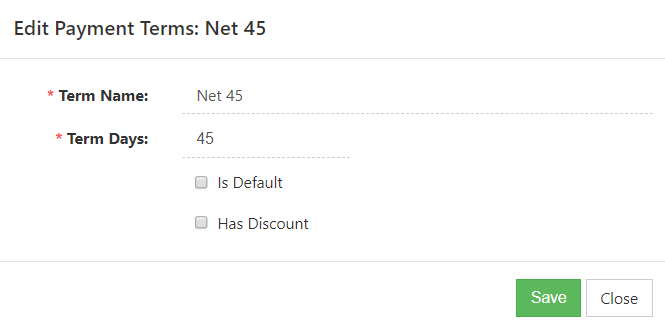
Example of Adding Payment Terms

-
Printable Formats
Customers can view Sales Orders and transactions in many ways from the Customer Portal, Email, or Mail. However, to provide a visual outside of the Portal, it’s recommended you create Printable Formats. Using the Invoice Formats will allow a PDF printable version to be sent to the Customer. If they’re using the Portal, they will be able to view and print out the Invoice so they have a hard copy for their records. There is a default Invoice format in Striven for your use, but you can also create your own. These are available with all Sales Orders and transactions including Invoices and Credit Memos. Printable formats function the same for all entities, but we’ll focus on Invoices in particular with examples as well. Below is an image of the Invoice Formats List from which you can edit or add printable formats.
To view Invoice Printable Formats, use the following steps below:
Company → Settings → Accounting → AR → Invoices → Invoice Formats
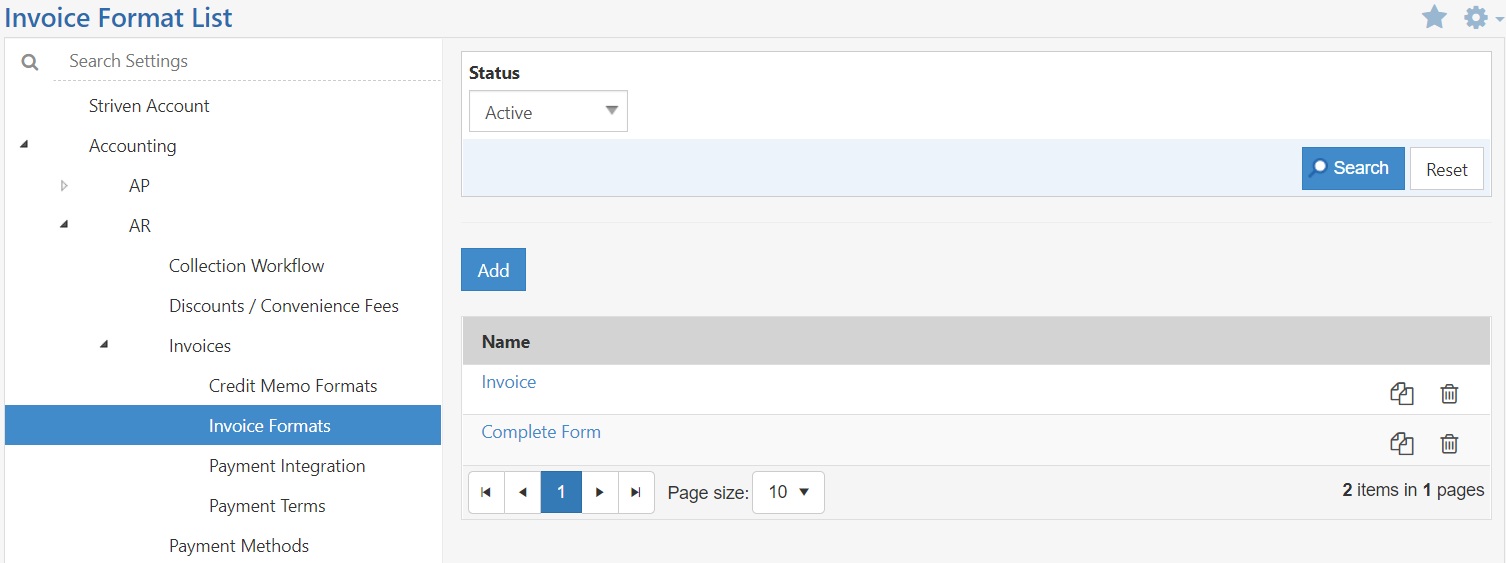
Example of Configured Invoice Formats

When creating a new printable format, there are three main sections available for you to configure to suit your Company’s needs including Content, Items, and Totals. Let’s discuss each section one by one and explore what each section can help you accomplish with printable formats.
-
Content
This section will allow you to utilize a text editor to add merge fields. Using merge-fields is very important when setting up Invoice Formats. The merge fields will take information from the Sales Order or transaction and merge it into the PDF automatically. Things like the Company Logo can also be added in using merge fields. Content sections can serve as Headers, Footers, or Terms & Conditions sections. Below is a screenshot illustrating how this section appears with merge fields and formatting.
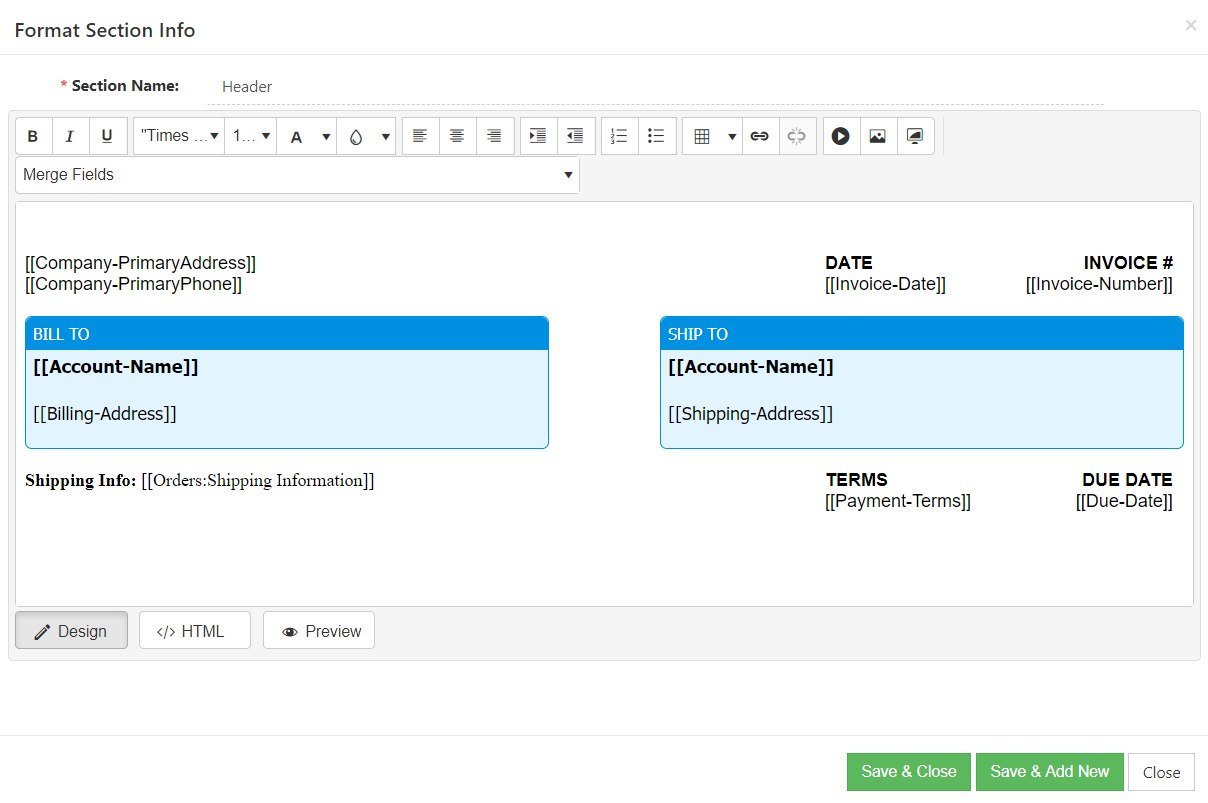
Example of Setting Up Content Printable Invoice Formats

-
Items
This section will allow you to configure how the Items appear on the printable format. To configure the section header, you can choose a column header background color, as well as a font size and color. Within the Items, you can also choose what to include and exclude in the section from Quantity, Name, Description, and more. The columns can also be renamed and rearranged to fit your needs. Below is a screenshot featuring how the Items section appears.
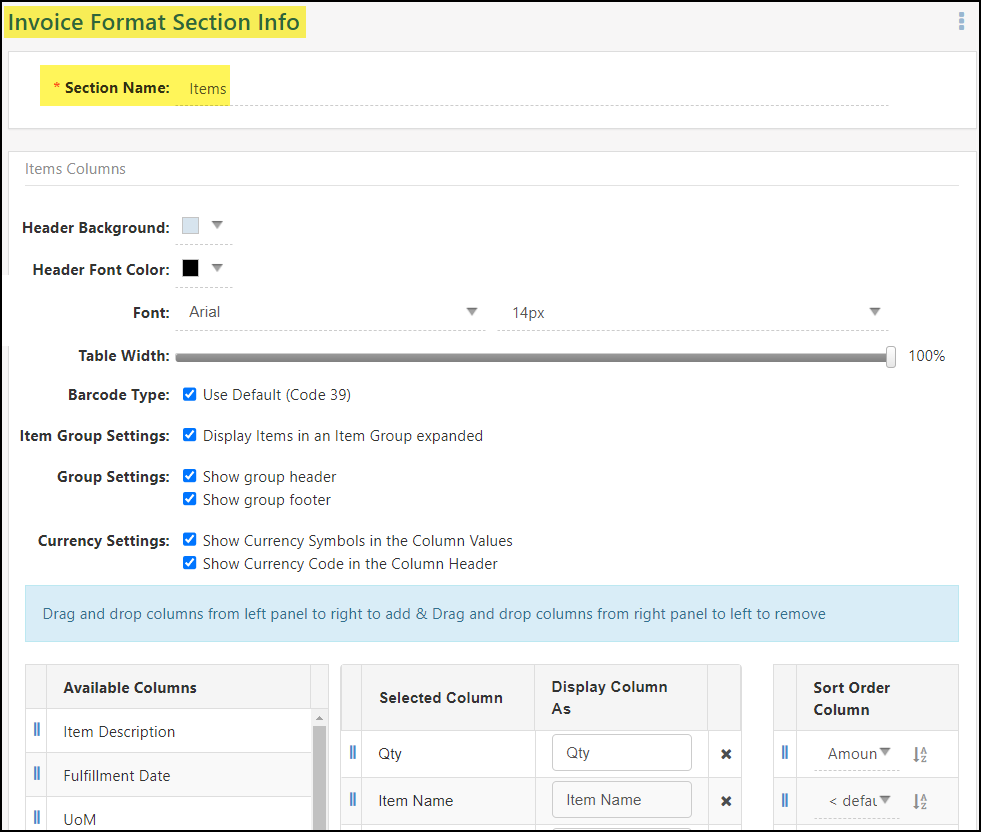
Example of Setting Up the Items Section Invoice Formats

-
Totals
The Total section will add everything up and total Line Items on the Invoice. This section also allows you to hide information deemed less vital to your Company using a series of checkboxes. By toggling the checkbox, this notes that the section will be hidden on the format. Below is an image displaying how this appears and what can be configured there:
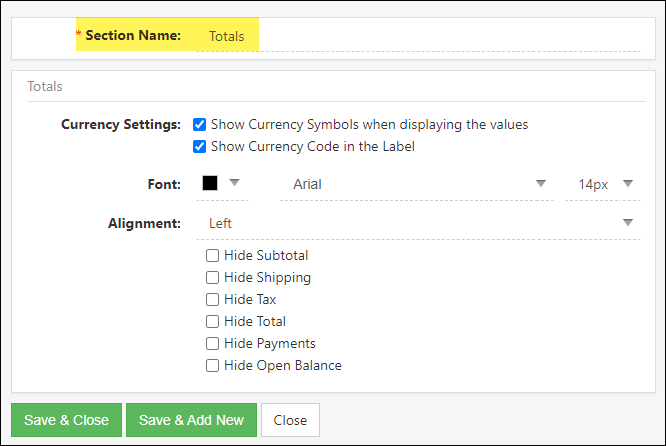
Example of Totals Section of Printable Formats

- Note: For information regarding printable formats for Line Item Grouping, visit the Sales Order Setup section of our Sales Orders Guide.
-
Page Numbers in Printable Formats
Striven’s Printable Formats have the option to include page numbering on transactions. To turn on page numbering for your transaction formats, you will need to find the page number checkbox on the Format Settings page, above your format sections.
When the box is checked, further options appear for you to select the page number font color, type, and size.

Example of Page Number Settings for an Invoice Printable Format

These page numbers will display in a “Page __/__” format on the bottom of your transaction pages, but only when printing a particular transaction. Printing in batches from the Invoice Print Queue, for example, will not display the page numbers.
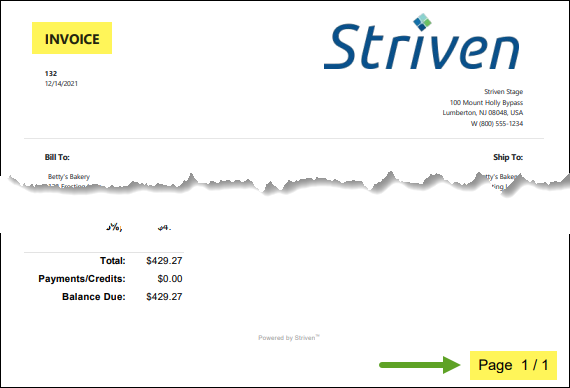
Example of Page Number Displaying on an Invoice

-
Currency Settings on Printable Formats
Currency display settings can be determined for transaction printable formats. These settings options are located on the Content, Items, and Totals sections of your formats. Striven provides the ability to select whether currency shows with currency symbols or currency codes.
The default setting for all printable formats will be to show the Currency Symbols (i.e. $, £, €, etc.), but you will also have the option to show the Currency Codes (i.e. USD, EUR, AUD, CAD, etc.) in addition to, or instead of the symbols.
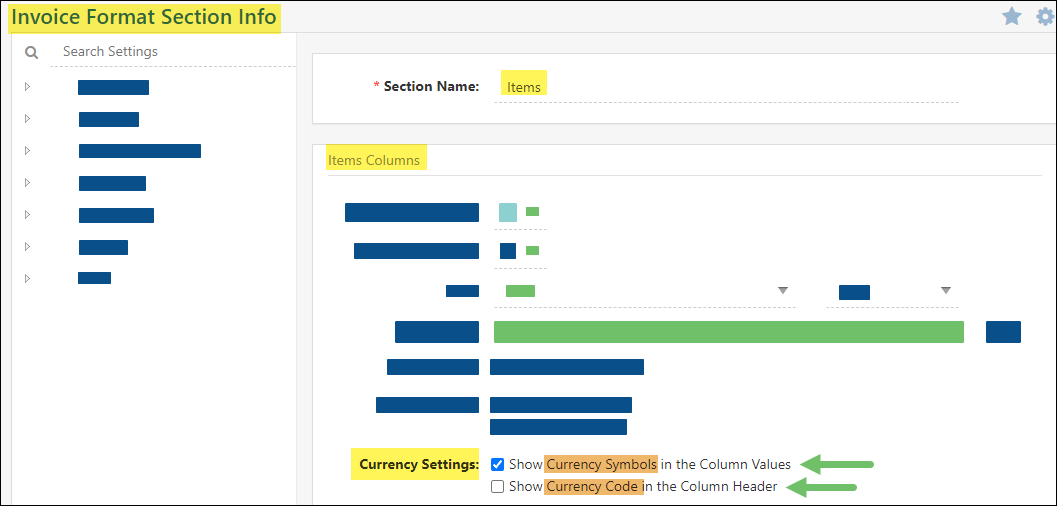
Example of Default Currency Settings for Items Section of an Invoice Printable Format

If you wish to remove a currency setting from displaying, simply uncheck the box next to the display option you do not want to be displayed.
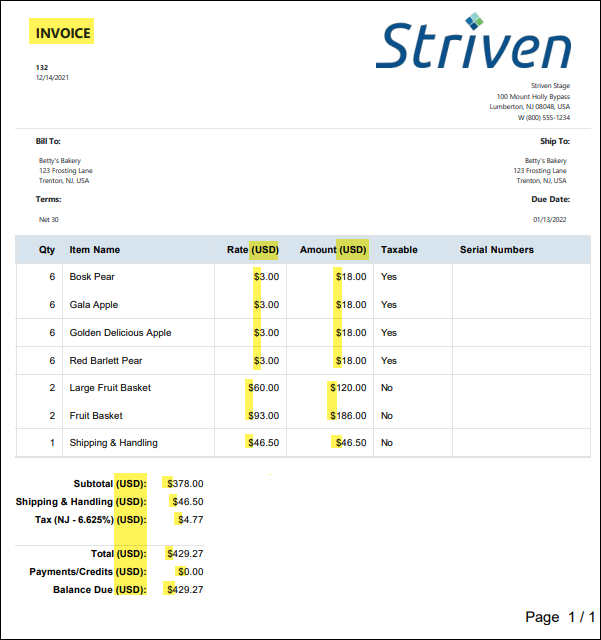
Example of Invoice Printable Format Displaying Currency Symbols & Currency Codes

-
Transactions List
The Transactions List is where you can find all the financial transactions in Striven. You can view individual transaction data from here as well. There are import tools located here which include ways to import Invoices, Payments, Bills, and Journal Entries. With each transaction listed here, there are two helpful hyperlinks including the Customer/Vendor Name and the transaction number. By clicking on a hyperlink, you can either view the Customer information by clicking on the Customer/Vendor name or the transaction details by clicking on the transaction number. Below is a screenshot representing how the Transactions List appears.
To view the Transactions List use the following steps:
Accounting → Transactions
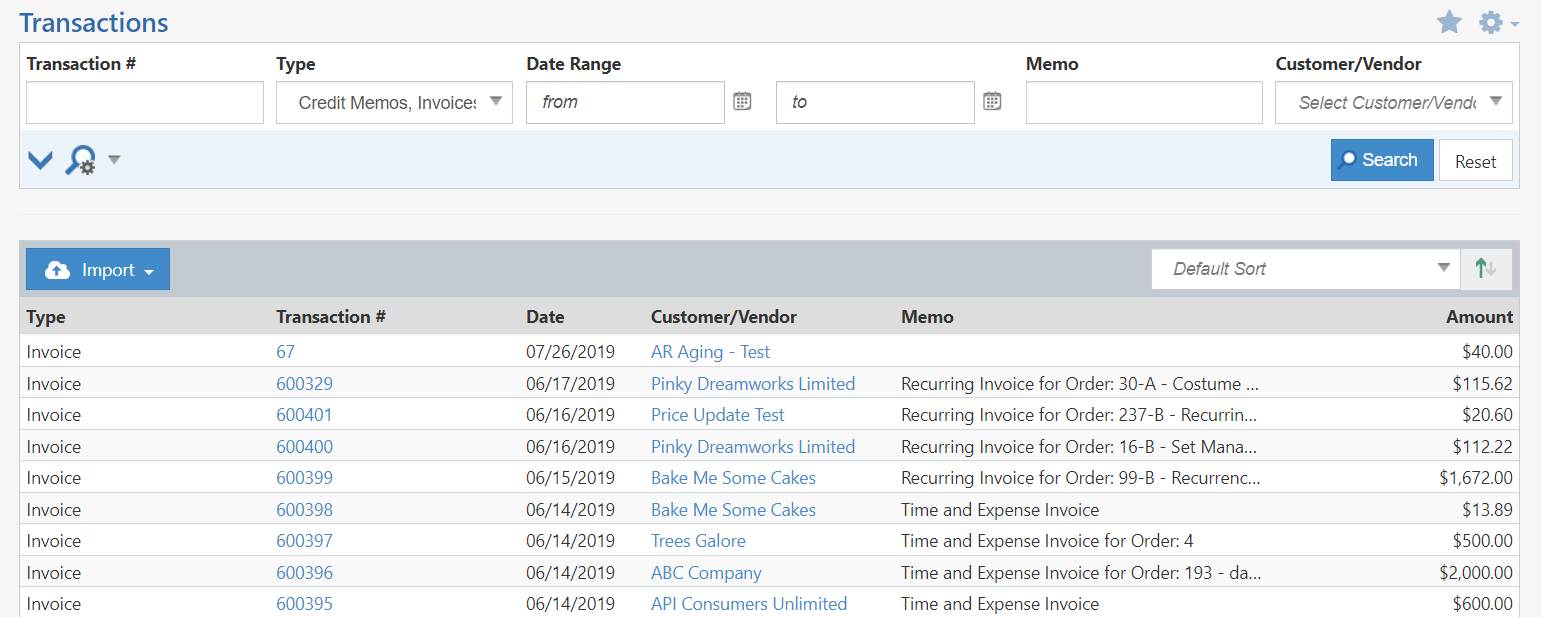
Example of Transactions List Page

-
Invoices
Invoices are transactions that represent money owed by Customers for goods or services you sell. Invoices can be generated from Sales Orders or generated on their own. On this page, you can add attachments to the Invoice if desired as well. Once the Invoice is generated, the transaction will post to GL Accounts in your Striven system and the Customer will be responsible for fulfilling Payment by the due date. Below is a screenshot depicting how adding an Invoice appears and details on what can be accomplished there.
- Customer Info: Displays who is purchasing goods or services from you and who they are dealing with from your Company. This section includes the following described below:
- Customer: The entity who is purchasing Items from you.
- Bill To: The Location that will be billed for the Items
- Ship To: The Location the Items will be shipped to.
- Sales Rep: The Employee who made the sale.
- Note: Customer/Vendor address changes will not reflect on existing transactions, only new transactions after the address change was made.
- Transaction Info: Information about the transaction and is described further below:
- Dates: Allows you to choose the date and due date for the transaction.
- Payment Terms: Choosing Payment Terms here will automatically adjust the due date based on the date chosen.
- Order: Allows you to associate a Sales Order to the Invoice. If the Invoice is generated from the Sales Order, the Order will be associated.
- AR Account: The Accounts Receivable Account the Invoice will post to.
- Format: Allows you to choose the Invoice printable format.
- Memo: Allows you to write a memo for the Invoice.
- Set as Recurring: Allows you to set the Invoice as recurring. By clicking this button, you can set either a daily, weekly, or monthly recurrence.
- Default Class: This option will only appear if you’ve chosen to track GL Classes in your Accounting Settings (reference our Accounting Setup Guide). By choosing a GL Class here, each Line Item added will automatically be assigned this GL Class. Classes can also be overridden at the Line Item level as shown by the number 4 in the sample screenshot.
- Unbilled Items: Allows you to add Items associated with the Customer that have not been billed yet. These include things like checks, time, etc.
- Items Section: Allows you to add Items that the Customer is purchasing. Options are described further below:
- Item: Choose the Item in your system the Customer is going to purchase.
- Description: The chosen Item’s description.
- Quantity: The number of Item units to be sold to the Customer.
- Unit Price: The price a single Item unit will be sold for.
- Amount: The price you are charging the Customer for the quantity ordered.
- S&H: Here you can enter shipping & handling charges per Item.
- Tax: Charges applicable taxes if checked.
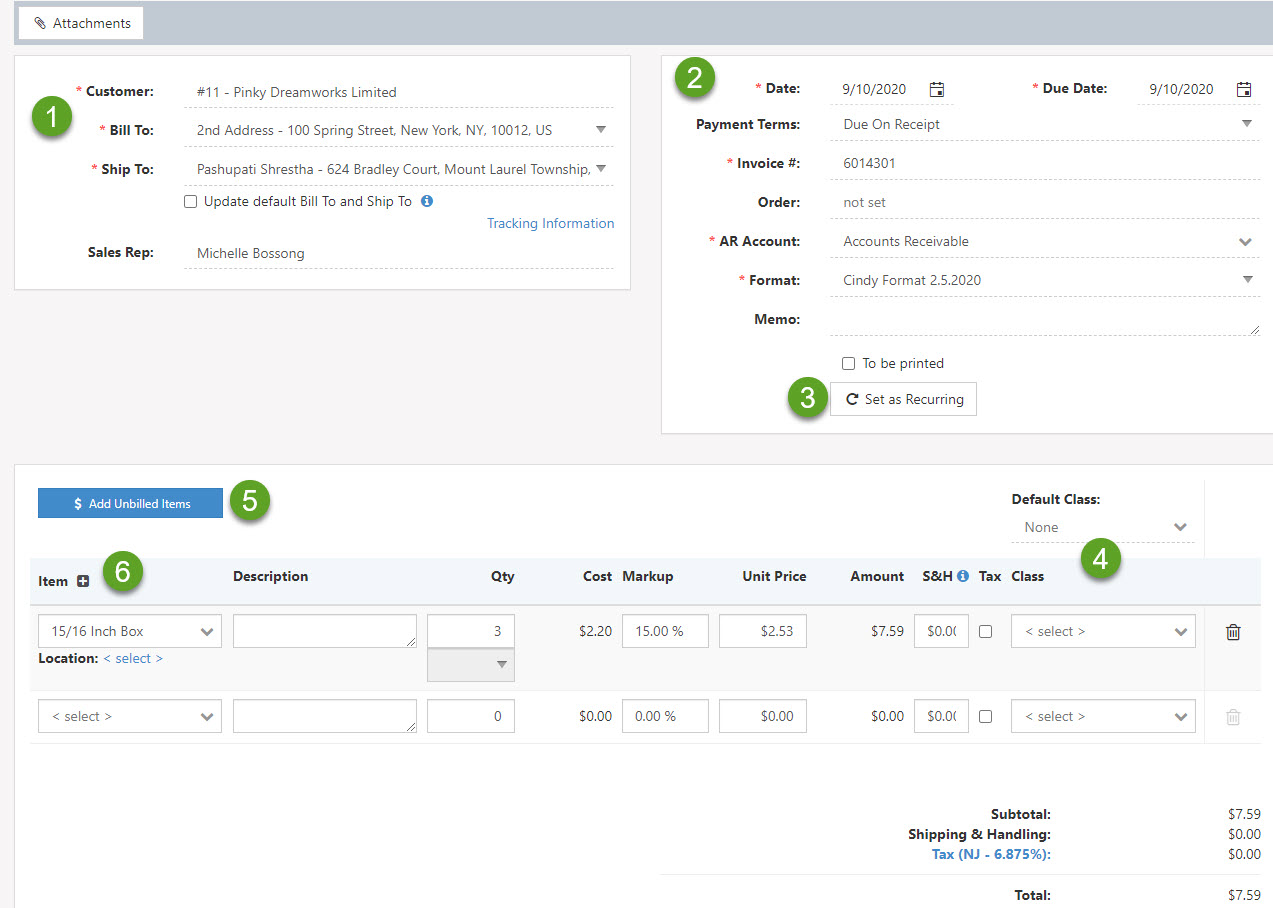
Example of Add Invoice Page

- Note: For information regarding the Discount Calculator on transactions, visit the Discount Calculator section of our Sales Orders Guide.
Sorting Line Items on Invoices
Line Items can be dragged/dropped to rearrange them into whatever order you wish them to display on the Invoice. This sorted order will be reflected throughout the system and any changes made to the Line Item order will be noted on the History page.
The Line Item order will also be maintained in the Portal view, as well as in the Printable Formats, as long as the format used hasn’t overridden the Sort Order Column setting at the Sales Order Format level.
When creating an Invoice from a Sales Order, whether manually or automatically, the Line Item order specified at the Sales Order level will carry over to the Invoice.
And while you will be able to rearrange Line Items within an Item Group, you will not be able to drag/drop Line Items between groups when Line Item Grouping is selected on Invoices.
- Customer Info: Displays who is purchasing goods or services from you and who they are dealing with from your Company. This section includes the following described below:
-
Credit Memos
Credit Memos are transactions that represent money that is credited or refunded to Customers who have purchased goods or services you sell. Credit Memos can facilitate crediting damaged products received by the Customer, and once saved there are three options to apply the credit. One option is to create a refund check to the Customer from the credit amount. Another option is to keep it as an open credit for the Customer, which will allow you to apply it to an Invoice later. The final option is to apply the credit to an open Invoice, which you can perform after choosing that option. Below is a screenshot demonstrating adding a Credit Memo and details of what can be accomplished there.
- Customer Info: Represents who is purchasing goods or services from you and who they are dealing with from your Company. This section includes the following described below:
- Customer: The entity who is purchasing Items from you.
- Bill To: The Location that will be billed for the Items.
- Ship To: The Location the Items will be shipped to.
- Note: Customer/Vendor address changes will not reflect on existing transactions, only new transactions after the address change was made.
- Transaction Info: Information about the transaction and is described further below:
- Date: Allows you to select the date of the transaction.
- Order: Allows you to associate a Sales Order to the Credit Memo.
- Format: Allows you to choose the Credit Memo printable format.
- Memo: Allows you can write a memo for the Credit Memo.
- Set as Recurring: Allows you to set the Credit Memo as recurring. You can set either a daily, weekly, or monthly recurrence.
- Default Category: This option will only appear if you’ve chosen to track GL Categories in your Accounting Settings (reference our Accounting Setup Guide). By choosing a GL Category here each Line Item added will automatically be assigned this GL Category. Categories can also be overridden at the Line Item level as shown by the other 4 in the sample screenshot.
- Items Section: Allows you to add Items to the Credit Memo transaction. Options are described further below:
- Item: Here you can choose the Item in your system the Customer is going to purchase.
- Description: The chosen Item’s description.
- Quantity: The number of Item units to be sold to the Customer.
- Unit Price: The price a single Item unit will be sold for.
- Amount: The price you are charging the Customer for the quantity ordered.
- S&H: Here you can enter shipping & handling charges per Item.
- Tax: Charges applicable taxes if checked.
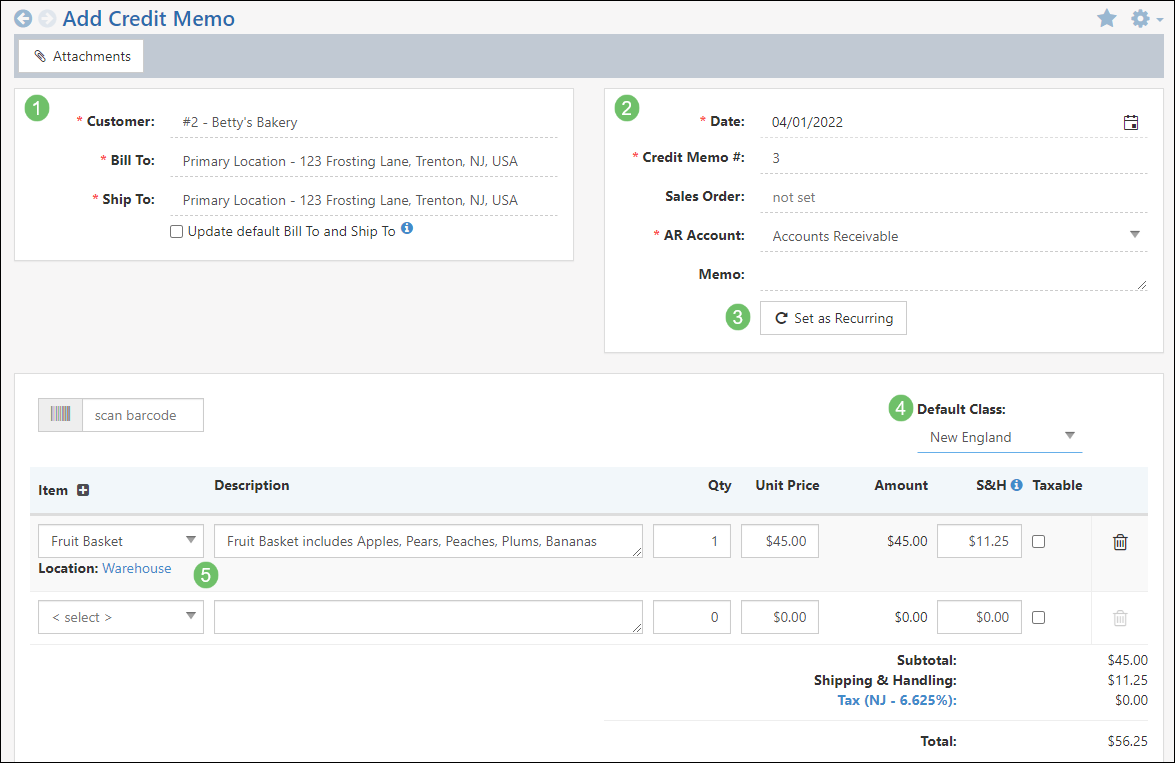
Example of Add Credit Memo Page

- Customer Info: Represents who is purchasing goods or services from you and who they are dealing with from your Company. This section includes the following described below:
-
Payments
Payments are transactions that represent money that is paid by those who purchase goods or services you sell. You can create Payments from Invoices or on their own. If you create a Payment from an Invoice, the Payment will pay off whatever amount on the Invoice the Payment is for. If you create a Payment on its own, you can apply the Payment to one or more Invoices for the selected Customer after the Payment is generated. Below is a screenshot displaying adding a Payment and details on what you can accomplish there.
- Customer: Allows you to select the Customer who is paying you.
- Payment Method: Allows you to select the Customer’s method of Payment. Payment Methods can be adjusted in the Settings.
- Received From: Allows you to choose from a list of the Customer’s Contacts who is paying you.
- Payment Date: Using the Calendar icon, you can choose the date on which you received the Payment from the Customer.
- Amount: Allows you to enter how much the Customer has paid you.
- Reference #: Allows you to enter a reference # for the Payment.
- Open Transactions: Shows a list of open transactions for which you can apply the Payment to once the Payment is created.
- AR Account: The Accounts Receivable Account the Payment will post to.
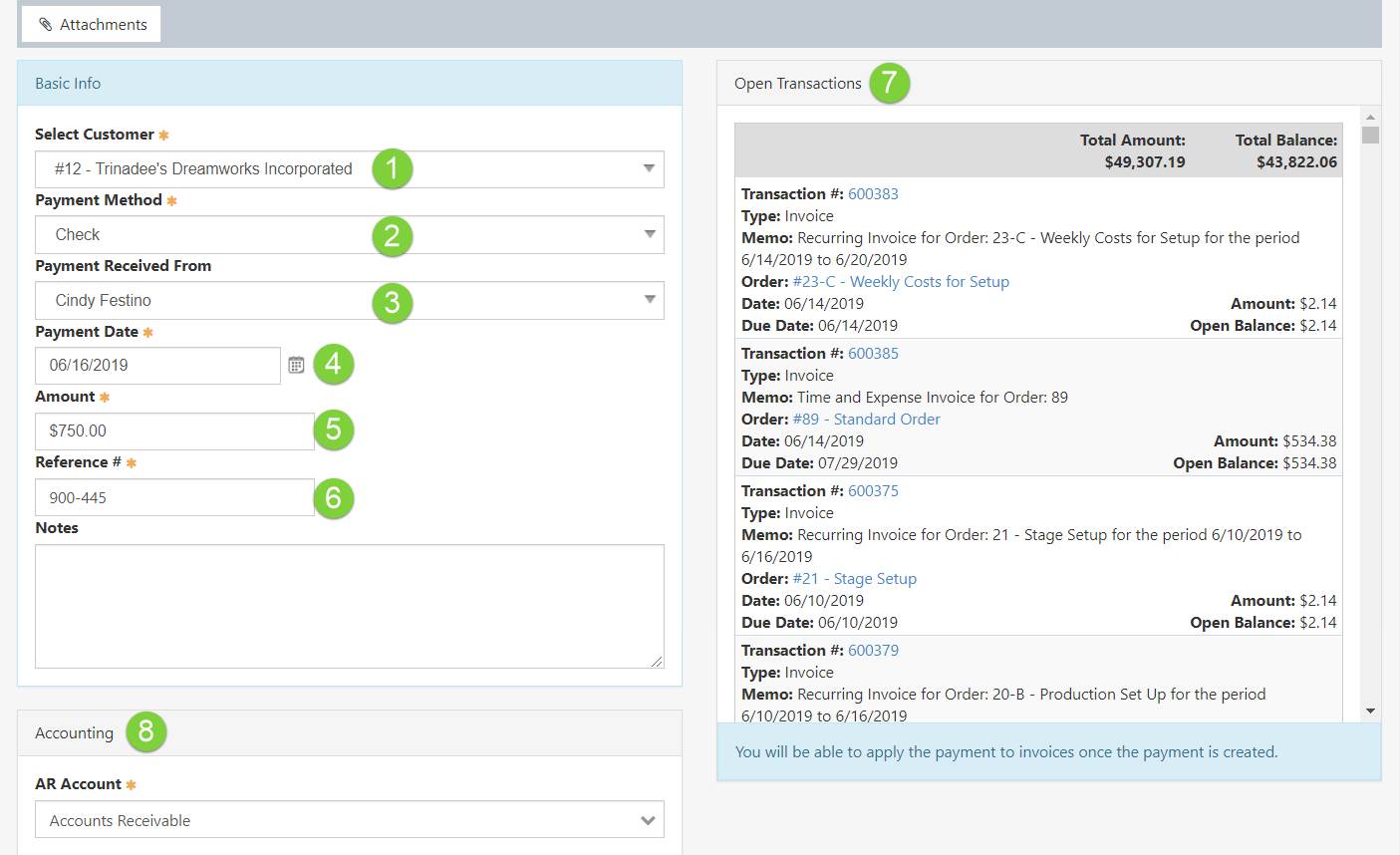
Example of Add Payment Page

-
Payment Refunds & Negative Deposits
Striven provides the option to create Refunds related to Payments. This feature is only available when Payments are in the Approved status and can only be issued against open Payments.
To issue a Refund within Striven, select the option from the Actions Menu on the Payment you wish to refund. See example below for reference.
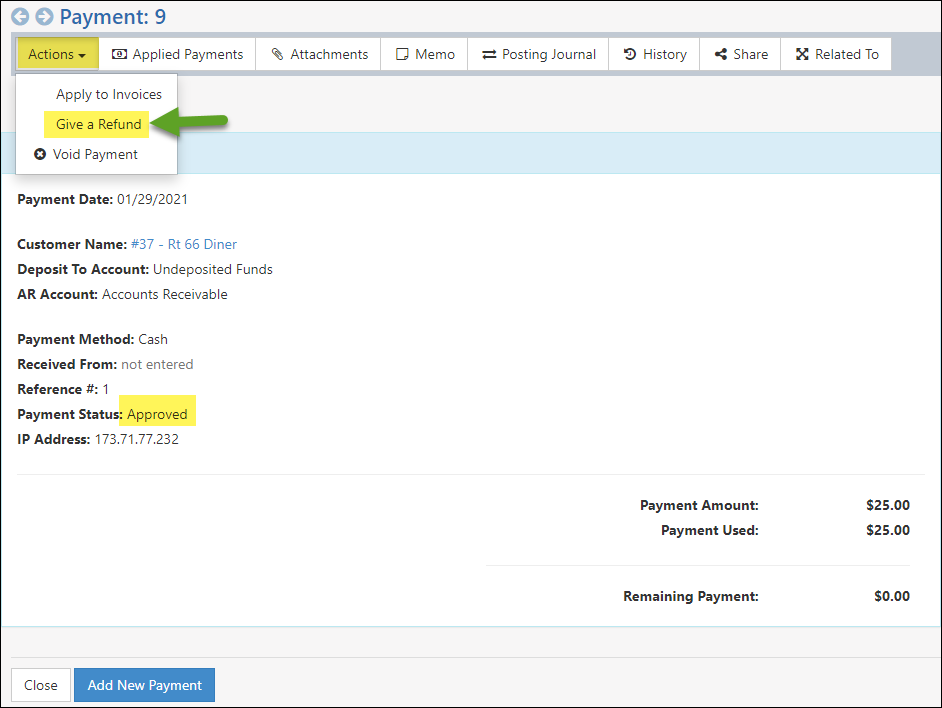
Example of Option to Give a Refund

While creating the refund, you can specify the Bank Account or select the Undeposited Funds Account. When the Undeposited Funds Account has been selected, the Bank Account selection is not allowed. Once the refund check is created, it will be applied to the Payment to affect its open balance. The refund will also display in the Related To transactions section of the Payment to show the Check Refund as a hyperlink to view the refund.
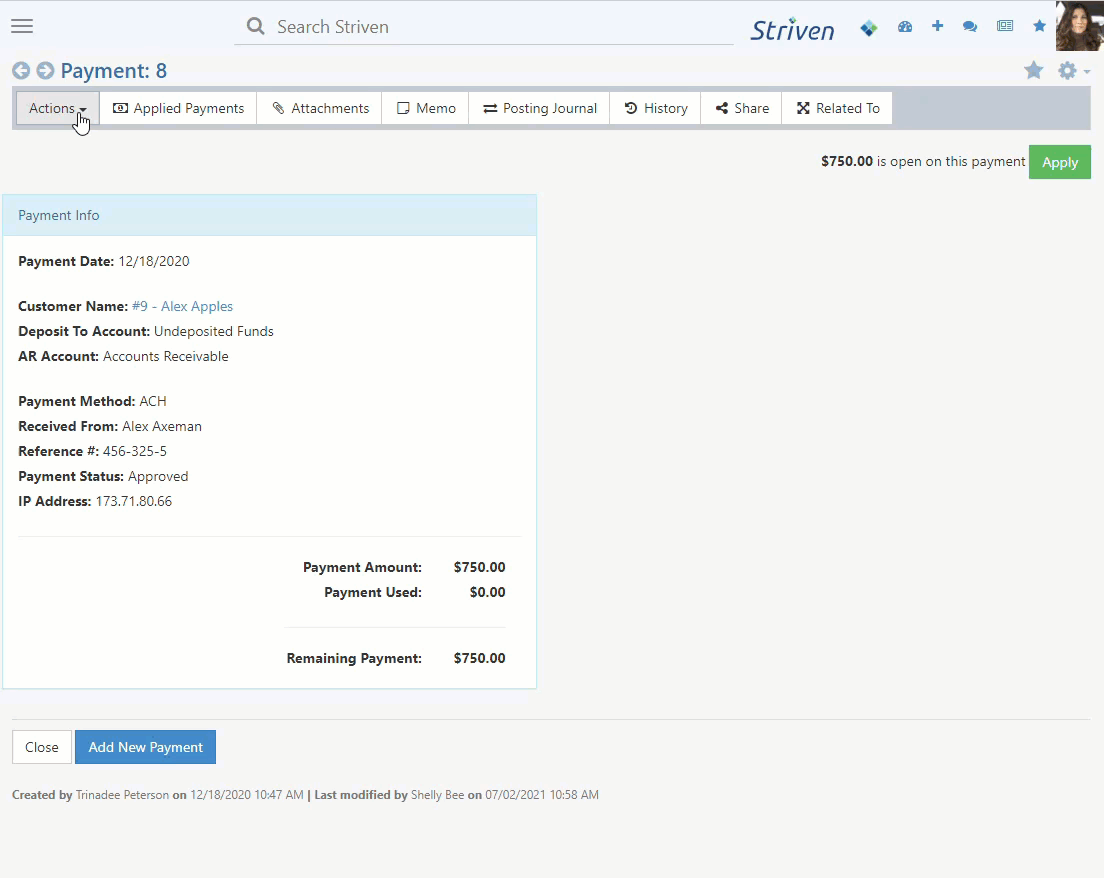
Example of Creating a Refund

Once the refund is created and you view the Refund Check you’ll notice the Bank Account field can be changed to any Bank Account as long as the Refund Check is not deposited.
When adding a deposit, the Refund Check will show with a negative amount. Once the deposit is completed, you’ll see the Bank Account field can no longer be changed when processing the Refund Check and the check cannot be voided.
The deposit will also display in the Related To transactions section for reference.
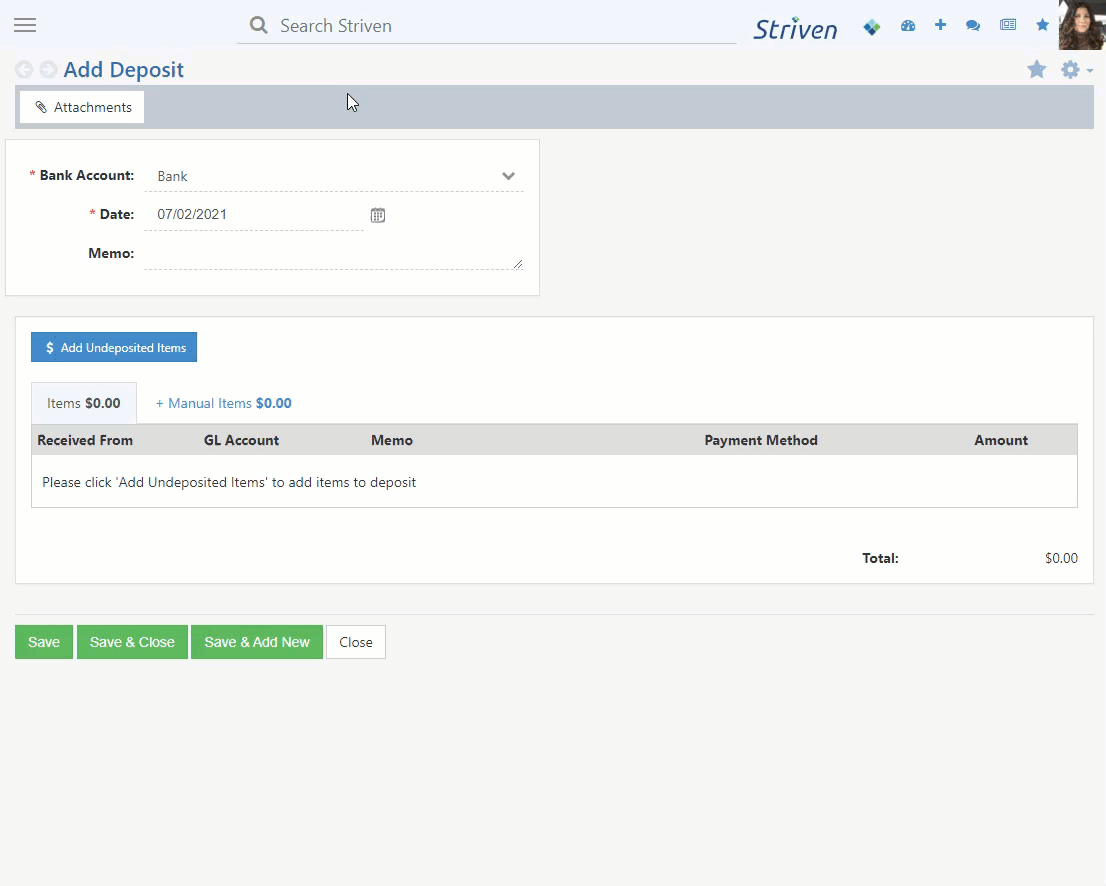
Example of Adding Deposit with a Refund

-
Sales Receipts
Sales Receipts can be employed to keep a record of any sales your Company makes. Once a Sales Order has been completed and the Invoice has been paid by the Customer, a Sales Receipt can be generated. Sales Receipts can also be created for sales made outside of Striven that affect your inventory count, such as over-the-counter transactions. This feature functions the same as a receipt from a point-of-sale would. An example of what creating a Sales Receipt looks like and the options available there are displayed below.
You can create a Sales Receipt from the Quick Add menu, or by navigating to:
Customers → Financial → Sales Receipt.
- Customer Info: Displays who is purchasing goods or services from you and who they are dealing with from your Company. This section includes the following:
- Customer: Entity who is purchasing Items from you.
- Bill To: The Location that will be billed for the Items. This can be selected once the Customer is selected.
- Ship To: The Location the Items will be shipped to. This can be selected once the Customer is selected.
- Sales Rep: The Employee who made the sale.
- Note: Customer/Vendor address changes will not reflect on existing transactions, only new transactions after the address change was made.
- Transaction Info: Information about the transaction:
- Date: Allows you to choose the date for the transaction.
- Reference #: Allows you to easily keep track of and reference the Sales Receipt.
- Payment Method: The method of Payment for the transaction.
- Payment Profile: Allows you to select Authorize.net Payment Profiles for the Customer. This setting becomes visible when Credit Card or E-Check are selected as the Payment method. This will be displayed depending on the Payment Method.
- Order: Allows you to associate a Sales Order with the Sales Receipt.
- Format: Allows you to select the printable format from your saved formats within Striven.
- Memo: Allows you to write a memo for the Invoice.
- Set as Recurring: Allows you to set the Invoice as recurring. By clicking this button, you can set either a daily, weekly, or monthly recurrence.
- Scan Barcode: Allows you to enter a barcode number associated with an Item to easily add that Item to the Sales Receipt.
- Items Section: Allows you to add Items that the Customer is purchasing. Some of the general options available here are described further below:
- Item: Choose the Item in your system the Customer is going to purchase.
- Description: The chosen Item’s description.
- Quantity: The number of Item units to be sold to the Customer.
- Unit Price: The price a single Item unit will be sold for.
- Amount: The price you are charging the Customer for the quantity ordered.
- S&H: Here you can enter shipping & handling charges per Item.
- Tax: Charges applicable taxes if checked.
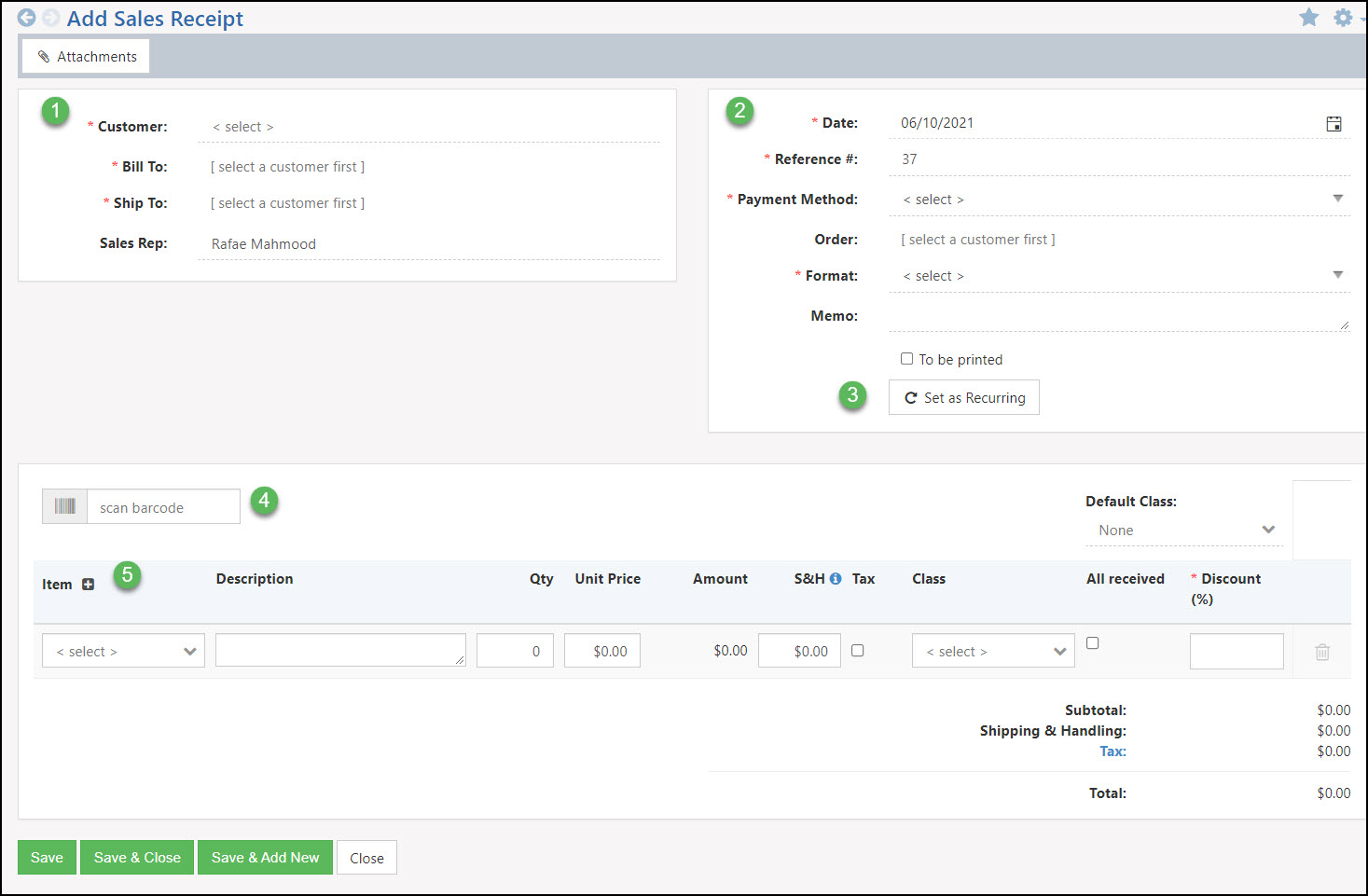
Example of Add Sales Receipt Page

- Note: There is a settings feature that allows you to add Custom Columns to your Sales Receipt format as well. To designate the settings for Custom Columns per Line Item for Sales Receipts, navigate to Company → Settings → Accounting → AR → Sales Receipts → Custom Columns.
Sorting Line Items on Sales Receipts
Line Items can be dragged/dropped to rearrange them into whatever order you wish them to display on the Sales Receipt. This sorted order will be reflected throughout the system and any changes made to the Line Item order will be noted on the History page.
And while you will be able to rearrange Line Items within an Item Group, you will not be able to drag/drop Line Items between groups when Line Item Grouping is selected on Sales Receipts.
- Customer Info: Displays who is purchasing goods or services from you and who they are dealing with from your Company. This section includes the following:
-
Journal Entries
Journal Entries are transactions in which Line Items represent GL Accounts which are either debited or credited to create an equal amount of Debits and Credits. When adding a GL Account on a Journal Entry, you can enter the amount in either the Debit or Credit field as needed. Debit and Credit fields will either show up or down arrows depending on the GL Account Type and how debiting or crediting affects the Account. In Striven Journal entries Accounts Receivable can be added on a Line Item, but A/R can also be billed to a Customer as well. Below is a screenshot exhibiting how Journal Entries appear.
To view Journal Entries use the following steps:
Accounting → Journal Entries
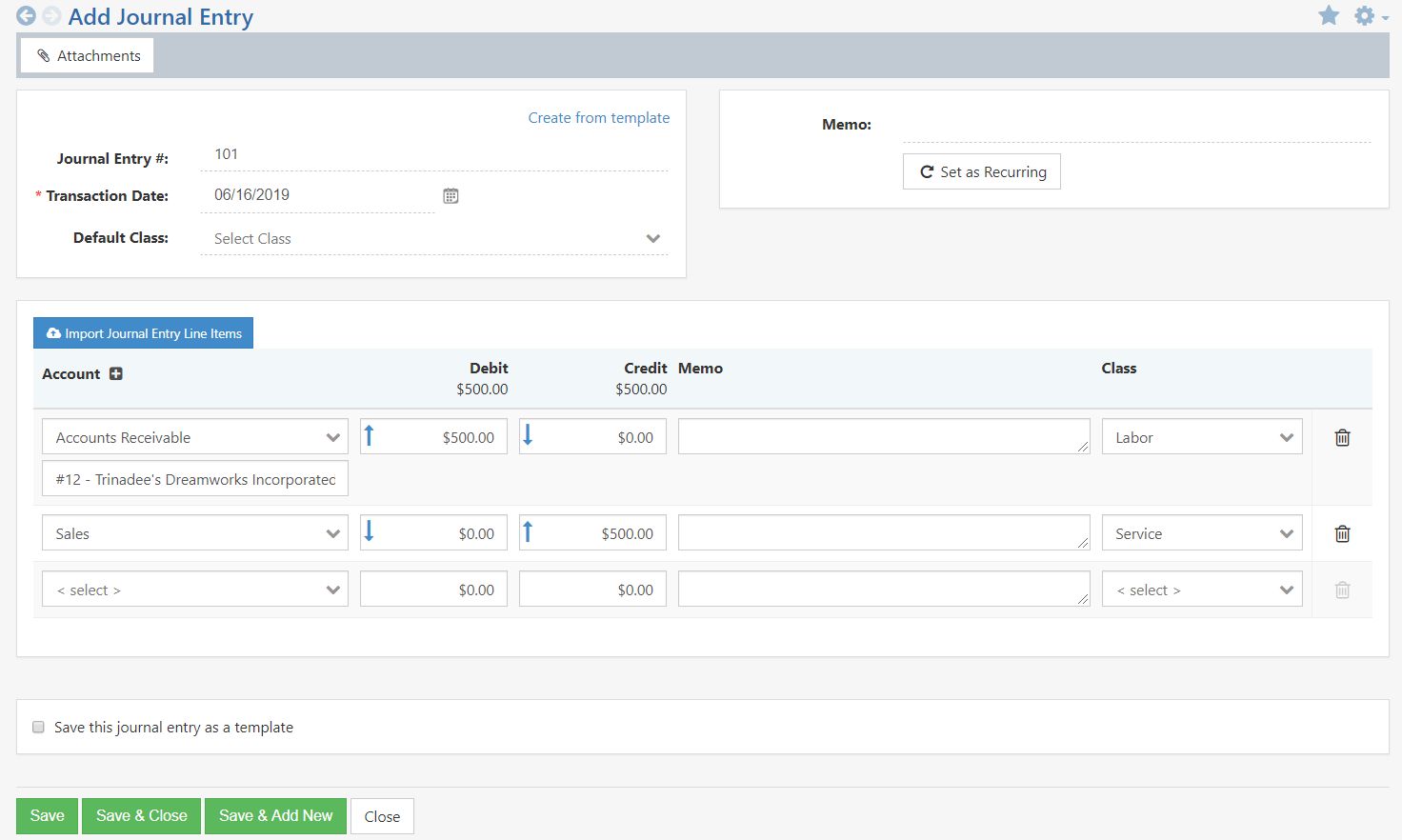
Example of a Journal Entry

-
Importing A/R Transactions
Striven has several imports available to allow you to import transactions en masse. Imports are available for A/R Transactions including Invoices, Payments, and Journal Entries. Though the mapping for each import is different the import setup functions much the same for all the imports. For more information about all imports, view our Import Management Guide. Transaction Imports can be accessed by clicking the Import button found on the Transactions List and choosing what type of transaction you would like to import into Striven. Each Import page appears with the same importing options which are described further below. A screenshot featuring how the Invoice Import page appears is also provided for reference.
- The Generate Sample File button initiates a Mapping popup detailing what goes into the import spreadsheet and allows for the selection of other available importing information options.
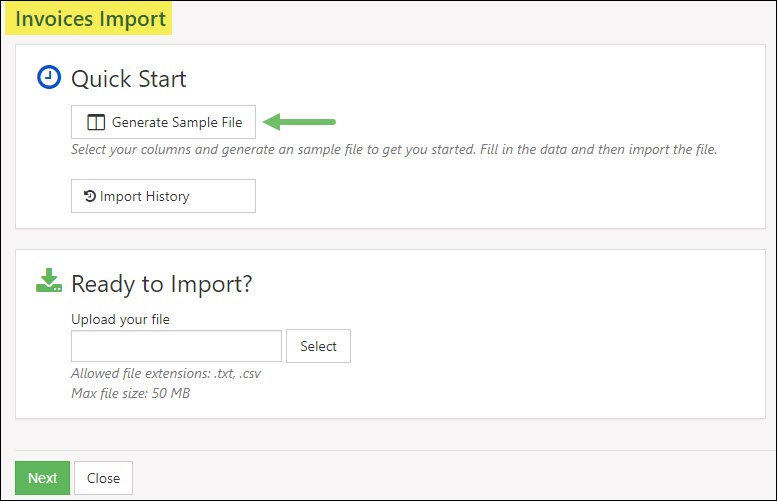
Example of Invoice Import Page

- The Download Sample button at the bottom of the Mapping popup provides a spreadsheet with pre-filled column headers (listed on the mapping) to assist with entering data.
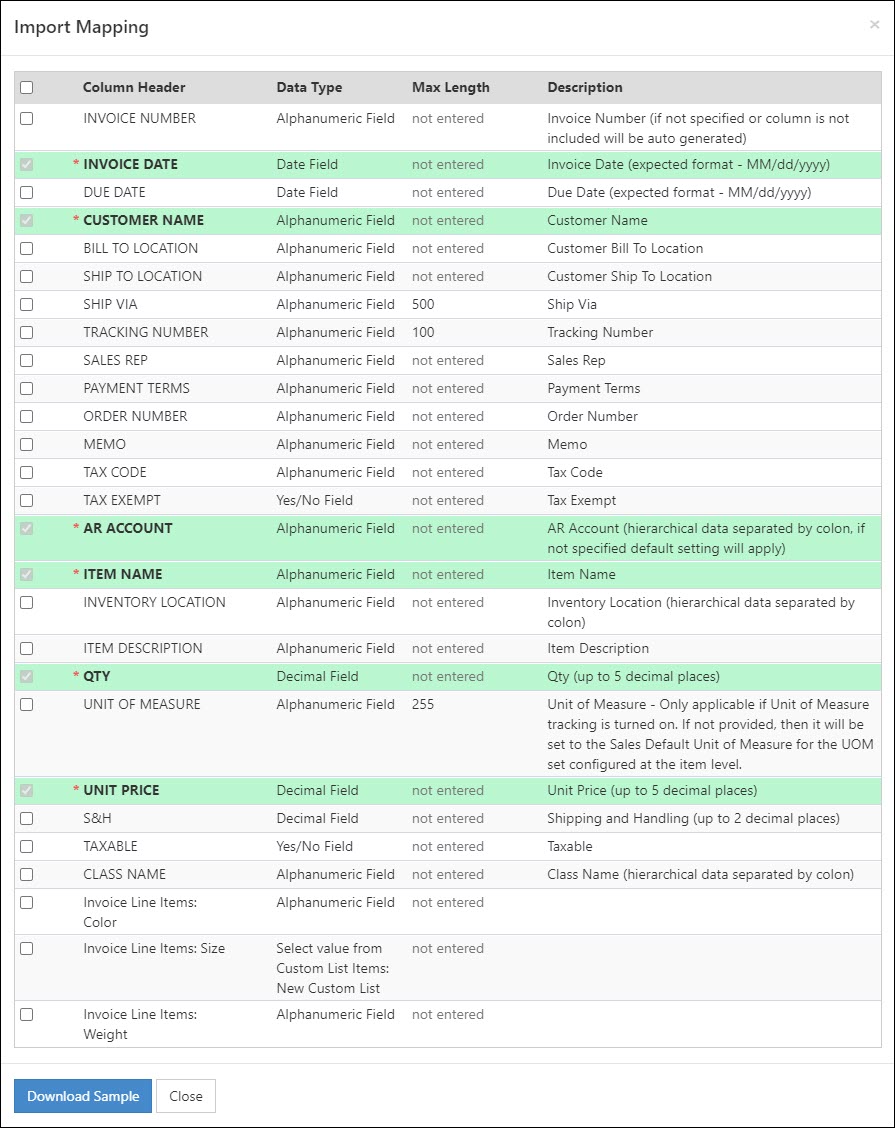
Example of Invoice Import Mapping Popup

-
Reports
There are many reports in Striven that help you gain insight into income you have made along with receivables that are still expected. Below is a description of some of the built-in reports in Striven that are geared towards reporting on your income and receivables.
-
Income by Customer
The Income by Customer Report will list out each Customer in order of how much income has been made within a given start and end period. The list is sorted by default by which Customer has contributed the most to the overall income within the selected time period. Below is an example of the Income by Customer Report and what configurations can be conducted, along with the path to the settings in Striven:
Reports → Income & Receivables → Customer
- Available Search Filters: There are many useful search filters available for this report in order to see the list of Customers that mean the most to you. Filtering based on Assignment can be a useful way to quickly see your Customers versus the overall list.
- Customer: Lists the Customer’s name as a hyperlink. Clicking on their name will navigate you to their Dashboard for additional information.
- Income Amount: Sums the total income that has been entered related to the Customer. The date range filter will determine which transactions are to be included within this calculated column.
- Income %: Displays how much the Customer has contributed to the overall income for your Company. Knowing which Customers have contributed the most percentage to your total income can help determine processes in regards to these types of Customers.
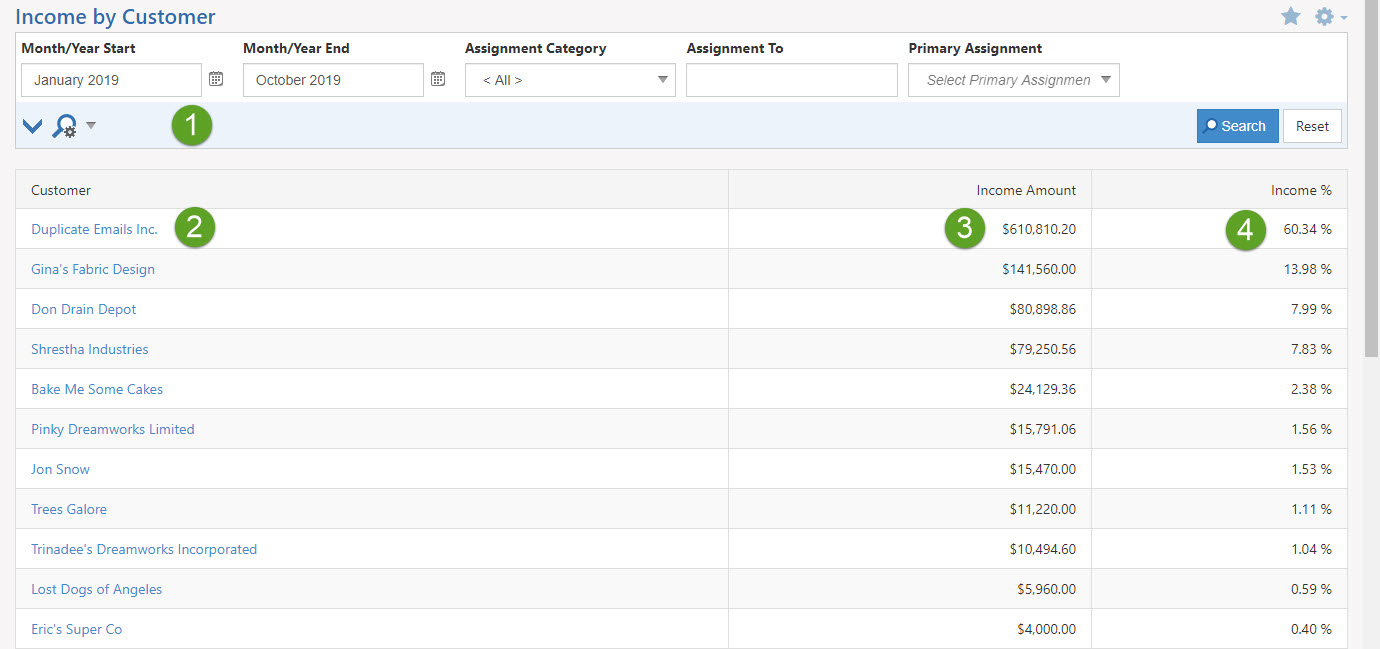
Example of the Income by Customer Report

-
A/R by Customer
The A/R by Customer Report will display useful information to a collection representative as they work through their list of overdue Customers. With the ability to update information right from the report, this becomes a working list that reps can work off of during their daily duties. Below is an example of the A/R by Customer report in Striven and what can be configured or accomplished using this report.
To run the A/R by Customer Report, navigate to:
Reports → Income & Receivables → AR by Customer
- Available Search Filters: Search filters are available to filter down the list of Customers you wish to be included in the A/R by Customer report. Filtering by the who is assigned to the Customer, how many days the Customer is past due, as well as only having the Customer appear if their open balance is greater than their credit limit are all useful filters that can be used and saved with Saved Searches within the A/R by Customer report.
- Customer: Displays the Customer’s name. Clicking on their name will navigate you to the Customer’s Dashboard for additional information.
- Primary Phone: Displays the primary number that is on file for the Customer. Displaying the primary number allows for this report to be used as a list for collection reps to quickly have a list of which Customers to call in regards to late Payments.
- Status: Displays the current status of the Customer. This will allow a collection rep to see from the list which Customers are currently active versus which ones have been set as lost.
- Credit Limit: If there has been a credit limit entered into the Customer’s info page, it will display here within this report.
- Open Balance: Displays the sum of the Customer’s open balance as a hyperlink in this column. Clicking on this link will navigate you to the Customer’s A/R tab with the filter to only show open transactions checked.
- Collections Log: Allows the collection rep to enter a note which will be date and time-stamped. The person who entered the note will also have their name displayed as well. Utilizing the Collection AR Log is a useful way to enter a note in order to make sure anyone who needs to be aware can look into the log.
- Next Call Date: Displays the date that has been set as the Next Call Date. This is a useful tool for collection representatives to note when they will next need to call the Customer with regard to their collections.
- Last Collection Notice: Indicates when the last Collection note has been sent to the Customer. Clicking on this link will display the note that was sent, when the note was sent, along with who sent the Collection notice to the Customer.
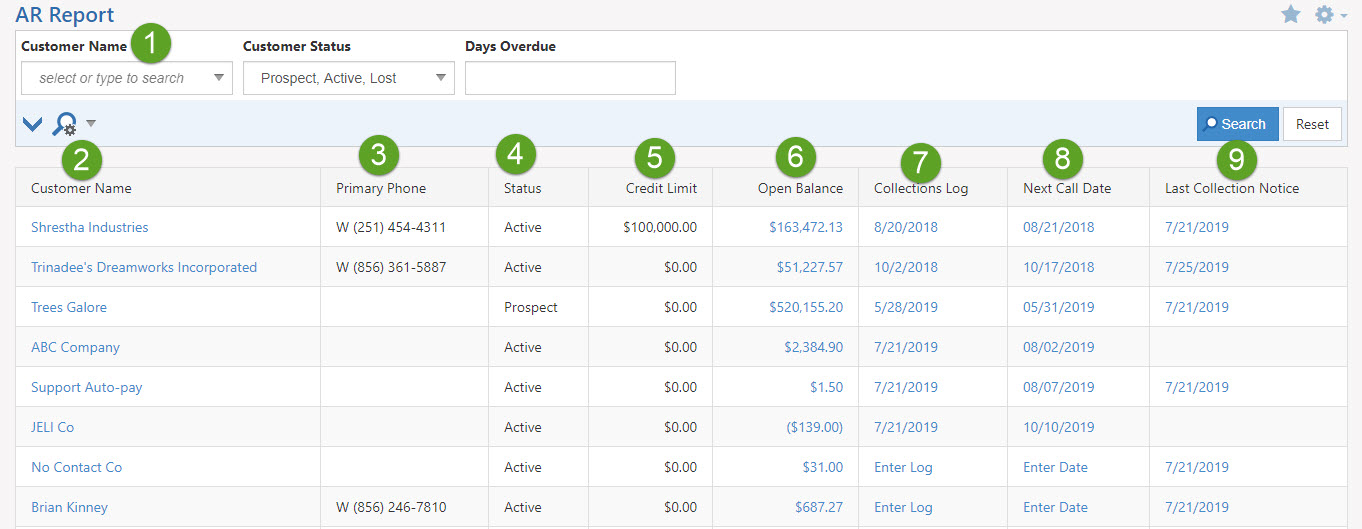
Example of AR by Customer Report

-
A/R Aging
Another tool you can utilize to help increase your collections workflow is the A/R Aging Report. The A/R Aging Report displays Customers who have an open balance and how far behind their Payments are based on the transaction’s Payment Terms. This report is very helpful to see transactions and the Customer’s open balance details on one report. Below is a screenshot representing how the A/R Aging Report appears and details on what can be accomplished there.
To view the A/R Aging Report use the following steps below:
Reports → Income & Receivables → AR Aging
- Date As Of: The date in which you are reporting from. The date can be selected by using the Calendar icon.
- Intervals: Represents a duration of days that you choose to report on and default to a 30-day interval. You can change intervals by entering a new number in this field.
- Buckets: Represents the max number of days you wish to report on based on the chosen intervals and default to 90 days. You can change the bucket by entering a new number in this field.
- Customer (Filter): Allows you to choose a Customer for which they can narrow down results to only display that Customer’s open balance.
- Customer (Name): Lists all the Customers who currently have an open balance. Customer Names are hyperlinks, which when clicked will populate the Customer’s Dashboard in a new tab.
- Total: Displays the overall open balance for each Customer and is a hyperlink, which when clicked will populate the Customer’s A/R Aging Detail report. The A/R Aging Detail will show all transactions with an open balance that make up the Customer’s Total.
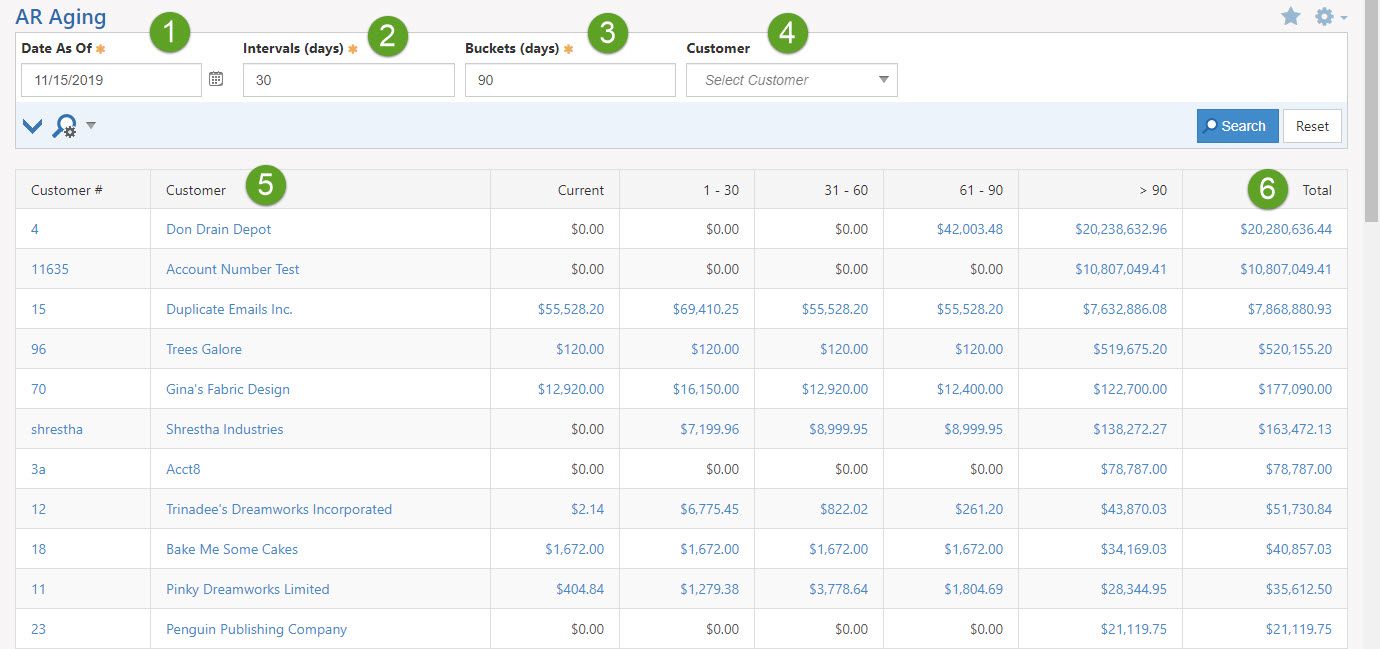
Example of AR Aging Report

-
Income by Item
The Income by Item Report allows you to see how much income is being made for the Company broken out by Item. This will indicate which Items are either the most sold or the most profitable based on transactions that have been created with the selected Item. Below is an example of the Income by Item Report in Striven.
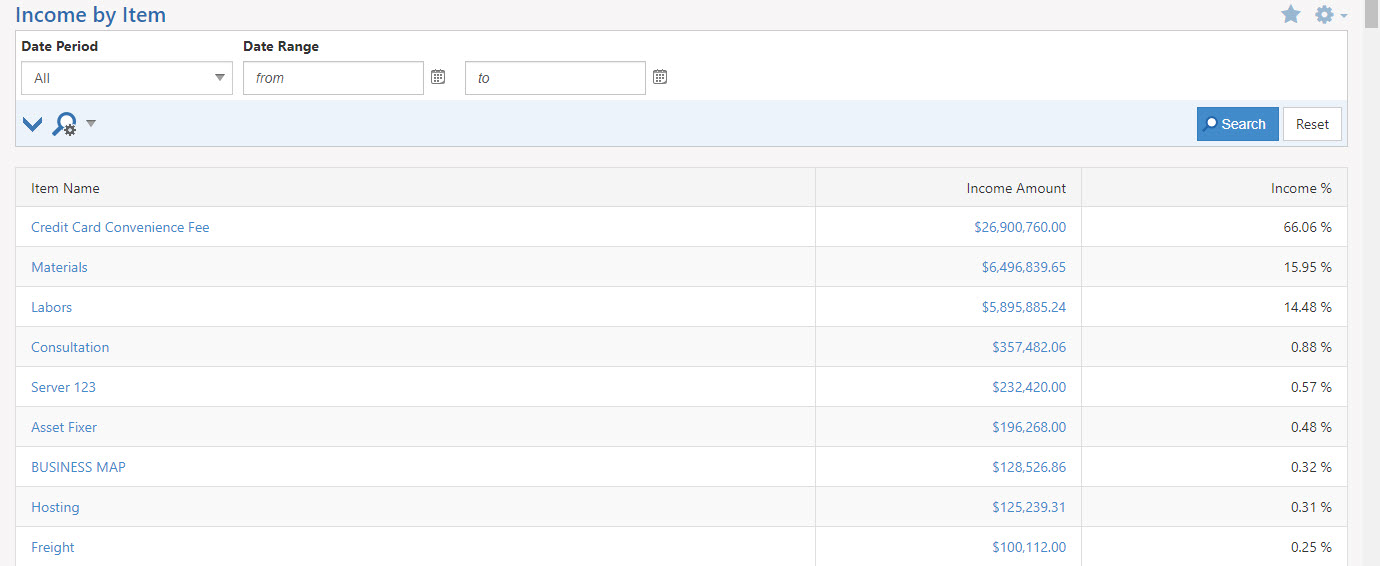
Example of Income by Item Report

-
Income by State
The Income by State Report allows you to see how much income you make for the Company based on each state that is set on Invoices and Credit Memos. This report can be filtered based on the Ship To address or the Bill To address that has been selected on transactions. Clicking into the amount for each state allows you to drill into the details as to what is making up that amount. Below is an example of the Income by State Report in Striven.
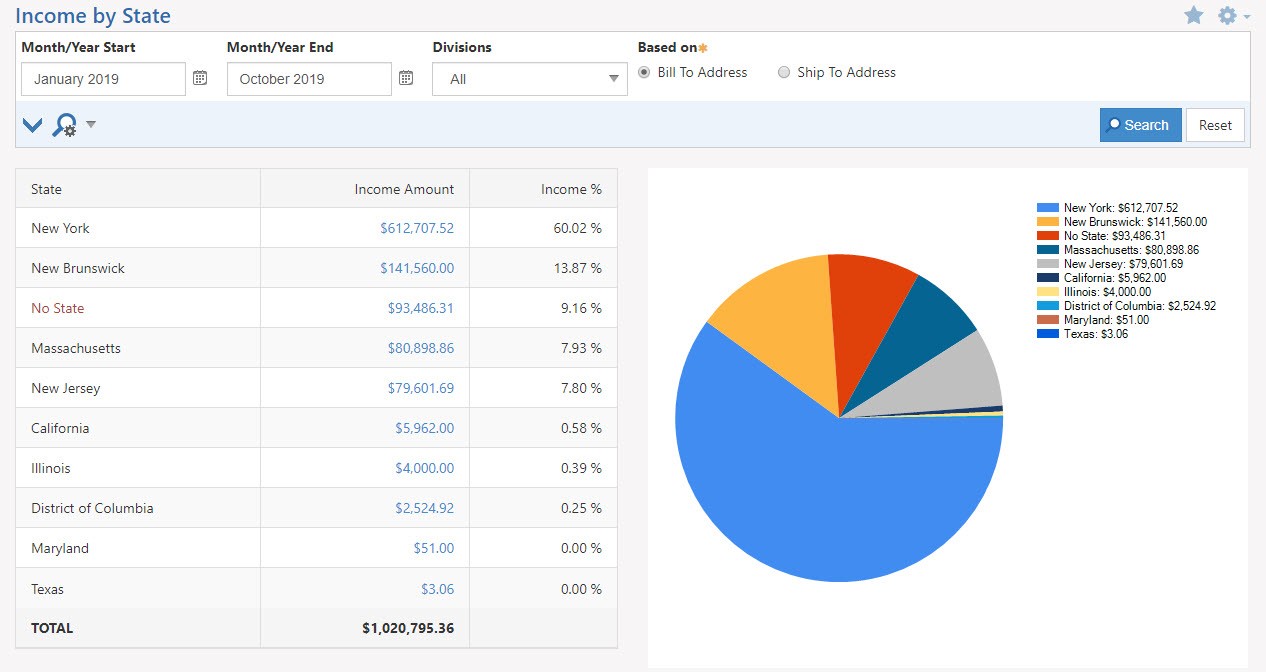
Example of Income by State Report

-
Revenue Projection Report
The Revenue Projection Report is a way to view your Company’s projected Invoice revenue over a specified date range. Date ranges on this report include today, next 7 days, next month, next 30 days, and custom. Custom allows you to select your own Invoice date range to report on. Other search filters include Division, Customer name, and Order Items. There is also a filter to limit results to either one-time Invoices, recurring Invoices, or both recurring and one-time. When you are ready to run the report, you can click the search button and you will be greeted with the following message:
- “The report you requested is currently being processed. This may take a few minutes. We will email you the report as soon as it is ready to view.”

Example of the Revenue Projection Report Upon Clicking Search

After clicking Search, you will receive an email with a hyperlink, which when clicked will display the report’s results and the date and time the report was run. This way of reporting lets you continue the work you are performing without losing any time in waiting for results to load.
Results on the report will be displayed in a few columns and sorted by Invoice date. Columns include Customer, Type of Income, Date, Related Order, Item Name, and Amount. The amount column also includes the total amount on the report at the bottom and top of the Amount column to provide the total at a glance on the report. Below is an example of how the Revenue Projection Report appears in Striven after you receive your confirmation email.

Example of the Revenue Projection Report

-
Recap
With this guide, we’ve discovered how to create and manage Accounts Receivable transactions, printable formats, and more to suit your Company’s needs. We explored some of the built-in reports within Striven to assist in tracking your financial transactions. We’ve also discovered ways to view and monitor Customer activities and settings to ensure the best user experience when managing financial transactions in Striven.
FAQs
-
My Customer has not gotten back to me yet. How can I tell if they have seen the Invoice yet or not?
If you view a Customer’s Transactions page from the Customer Navigation waffle menu, you will see a list of all your transactions with that Customer. There will be a Magnifying Glass icon next to the transaction name. If you click on that icon, there will be a list of the date and time of each time the Invoice was viewed on the Customer/Vendor Portal. This will also give you the name of the Contact who has viewed the transaction as well. If there is no Magnifying Glass icon next to the transaction name, that means it has not been viewed yet.
